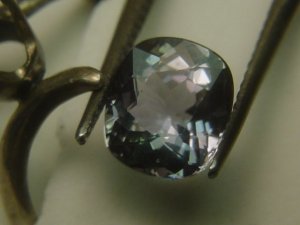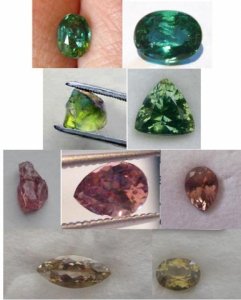RedSpinel
Shiny_Rock
- Joined
- Apr 28, 2012
- Messages
- 211
When I first started seeing lots of tanzanite being sold on the internet, jewelry stores, TV, etc. it was about 9 years ago. back then Tanzanite seemed to come in 3 main color grades. The best was that pure, royal blue with no noticeable violet tint. Obviously Tanzanite is trichroic, so you will get flashes of other colors like red occasionally, but the primary color in the top grade tanz. was royal blue.
The next level down was blue-violet. It would be mostly blue, but with some violet tint to it. The lowest quality tanz. was just pure violet. It had no blue, only violet. It was always the cheaper Tanzanite material. There would be some fluctuation within these categories of how blue or violet was visible, but the colors were pretty standard.
But in the last few years, I'm now seeing lower to mid priced Tanz that is mostly blue, but its not the same blue you'd see 8-9 years ago. Its a different shade of blue altogether. There seems to be more of this and less pure violet stones. I know that Tanzanite has been treated for almost as long as its been available, but I'm wondering if they have come up with new or modified treatment that is resulting in these newer colors, and resulting in the lack of the pure violet stones. Maybe they can now take the violet rough, treat or heat it in a "revised" manner, and turn it blue-ish instead.
Also, the top grade. pure royal blue Tanzanite seems to be less common than before, and some dealers are selling the blue-violet, mid grade stones and calling them top grade, and even going as far as to tell their customers that top grade Tanzanite is SUPPOSED to have obvious violet in it, and not pure royal blue! Others will tell you its pure blue, even while you're looking at a stone that is 30-50% violet!
I know there used to be 4 different mine blocks that the rough came out of, and supposedly "D" block was best, and "C" block was where the violet stuff came from, at least thats what I read years ago.
The next level down was blue-violet. It would be mostly blue, but with some violet tint to it. The lowest quality tanz. was just pure violet. It had no blue, only violet. It was always the cheaper Tanzanite material. There would be some fluctuation within these categories of how blue or violet was visible, but the colors were pretty standard.
But in the last few years, I'm now seeing lower to mid priced Tanz that is mostly blue, but its not the same blue you'd see 8-9 years ago. Its a different shade of blue altogether. There seems to be more of this and less pure violet stones. I know that Tanzanite has been treated for almost as long as its been available, but I'm wondering if they have come up with new or modified treatment that is resulting in these newer colors, and resulting in the lack of the pure violet stones. Maybe they can now take the violet rough, treat or heat it in a "revised" manner, and turn it blue-ish instead.
Also, the top grade. pure royal blue Tanzanite seems to be less common than before, and some dealers are selling the blue-violet, mid grade stones and calling them top grade, and even going as far as to tell their customers that top grade Tanzanite is SUPPOSED to have obvious violet in it, and not pure royal blue! Others will tell you its pure blue, even while you're looking at a stone that is 30-50% violet!
I know there used to be 4 different mine blocks that the rough came out of, and supposedly "D" block was best, and "C" block was where the violet stuff came from, at least thats what I read years ago.







300x240.png)